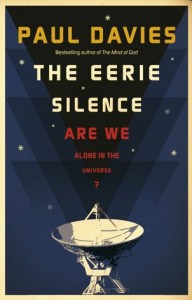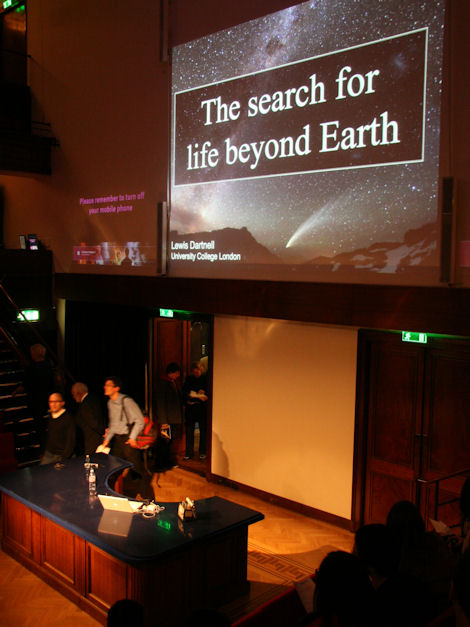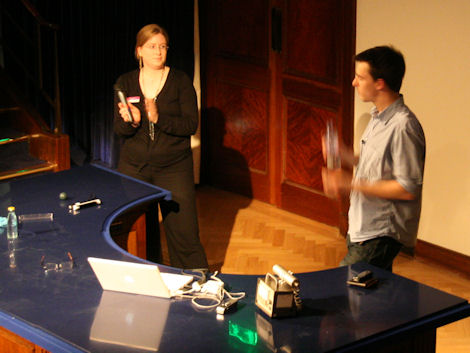Book review: The Eerie Silence: Are We Alone in the Universe?
Author: Paul Davies
Hardcover: 260 pages
Publisher: Allen Lane (4 Mar 2010)
ISBN-10: 1846141427
ISBN-13: 978-1846141423
The search for extra-terrestrial intelligence, or SETI, is in a rut. That is Paul Davies’s message in ‘The Eerie Silence – Are we alone in the Universe’ – a thorough taking stock of the programme started by Frank Drake in 1959 to search for alien radio messages from outer space.
Davies wants a rethink from scratch, where we shake off the blinkers of anthropocentric thinking and question exactly what we should be looking for. Listening out for a direct radio message is fine, but lets extend the search to include more subtle evidence of alien legacy and the very origin of life.
ET has indeed been strangely quiet, and for Davies two rather extreme explanations for that are providing signposts to a ‘New SETI’.
Under the first option, we have to accept that life on Earth was born of a series of events so incredibly flukey they will never be repeated. Under the second, we face the chilling prospect that intelligent life pops up quite frequently, only to develop a propensity for technology fueled self-destruction.
Holding out hope for a middle way, and putting speculation over self-destructing aliens aside, Davies argues there is a raft of solid science we could be getting on with to better understand the scarcity of life. Those up for the task (and skilled enough to secure funding) will enter a field of polarised opinions and a paucity of hard evidence. The prize? – possibly the final word on the question of whether life is ubiquitous in the universe – a ‘cosmic imperative’ – or that you and I here on Earth are a one-off, somewhat lonesome, rarity.
We should still listen for radio messages, says Davies, enthusing over SETI’s groundbreaking Allen Telescope Array (ATA) of radio telescopes; but the emphasis should be on searching for new types of evidence of intelligence, both in space and closer to home – on Earth in fact.
If we can show life on Earth started independently more than once – a second genesis if you like – the fluke theory is destroyed and the prospect of life existing on the billion or so Earth-like planets in our galaxy increases immensely. Once life has started, there is pretty much universal agreement among scientists that Darwinian style evolution will, environmental factors willing, take over to produce complex life forms and probably intelligence and consciousness. Second (and third and fourth..) genesis life forms could be living alongside us today, unrecognised as a microbial ‘shadow biosphere’ – the holy grail for researchers now culturing candidate samples from Mono Lake in California. Or we might find tell-tale markers of an extinct second genesis in geological records that we have seen but incorrectly interpreted. With so many work areas highlighted as candidates for inclusion in New SETI, a problem for potential researchers could be deciding where to focus their application. Presumably Davies is taking calls.
Moving from Petri dish to telescope dish, Davies believes our pre-conceptions of ET in space are causing us to define too narrow a target there also. Any intelligent biological life, he says, will quickly transition to an intellectually superior machine form having nothing in common with Homo sapiens and little to gain from interstellar chit-chat.
Or the aliens may have launched beacons that ping data packets only once a year. Or they may have sent probes – monolith fashion – to lurk around our solar system, programmed to spring to life when we learn to think up to their level. The point is we will only detect this kind of activity if we specifically look for it.
In his most futuristic speculation, Davies envisions life evolving into a quantum computer – an extended network of energy floating through space, amusing itself solving complex mathematical doodles. The implication of course, if such ‘beings’ exist, is that we are headed in the exact same direction. How do you fancy being a node in a pan-galactic thought matrix?
Among other thought-provoking revelations, we learn the Earth has for billions of years been happily swapping rocks, possibly with primitive life aboard, with other planets in the solar system – including Mars. That makes the potential discovery of life on that planet important, but not necessarily a game-changer for SETI, as Martian and Earth life could share the same unique origin.
Davies puts SETI into historical context on a quirkier note, recounting how the mathematician Karl Gauss, as early as the turn of the 19th century, planned to signal the Martians using huge shapes cut out of trees in the Siberian forest.
There is an implicit appeal in The Eerie Silence for scientists from different disciplines to work together on SETI and astrobiology – maybe a guiding principle for New SETI? Astronomers, biologists, geologists, engineers, astro-physicists and cosmologists all have a role in the search – as do non-scientists.
That also holds true for the post-detection task-group Davies leads, set up to advise an appropriate response in the event ET finally calls. In a chapter devoted to the implications of ‘first contact’, he asks how various groups: from the media, through politicians, the military, and religious believers might react. If we receive a targeted message, we should certainly think carefully about the reply. But that we already send the occasional burst of blindly targeted radio messages into space is a positive in Davies’s book; at least it makes people think about science, humanity, and what in our culture we value. Religion, and particularly Christianity, Davies believes, will struggle to reconcile dogma with the existence of intelligent aliens.
In his wind-up, Davies keeps all options open as to the chances of a positive outcome for SETI. But on balance, hardcore enthusiasts of radio SETI in particular may well find the The Eerie Silence a bit of a downer. Likewise, those looking for evidence to support more philosophical ideas around nature favouring life, or the existence of a life principle buried in the physics and chemistry of the universe – themes Davies has arguably been more sympathetic to in previous works – will be disappointed as he rejects each in turn.
To its credit, The Eerie Silence is as much about human motivations and psychology as it is about research and radio antennae. A chatty narrative with frequent episodes of self-examination strikes chords with thoughts and feelings most of us will have had: like the need for a sense of self, and a yearning for meaning. The search for ET is very much the search for what we are, what we may become, and what ‘it’ all means. A cliched theme maybe, but well supported here with relevant facts and reasoned speculation. Davies’s talent for projecting rock-solid scientific rationalism while not (entirely) closing the door on other perspectives has produced an absorbing read.
Other posts related to astrobiology and SETI on Zoonmian
How would you break the eerie silence – competition winners
Royal Society’s meeting on astrobiology and the search for extra-terrestrial life (SETI)
Interview with an astrobiologist (Lewis Dartnell) and Life, Talk to me about Life



